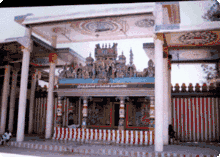Shri Pathirakali Mariamman Temple
Shri Pathirakali Mariamman Temple (Tamil: ஸ்ரீ பத்திரகாளி மாரியம்மன் திருக்கோவில்) is one of the oldest temples in Madurai district. The Thirumangalam city is known that the mangalyam for goddess Meenakshi of Madurai was designed and done here, so the name Tiru+Mangal(y)am came. In other way, it is said that when lord Murugan married Theivanai in Thiruparankundram (nearest to Tirumangalam), the "Tirumangalyam" was made here and hence the name came
| Shri Pathirakali Mariamman Temple | |
|---|---|
ஸ்ரீ பத்திரகாளி மாரியம்மன் திருக்கோவில் | |
 | |
| Religion | |
| Affiliation | Hinduism |
| District | Madurai |
| Festivals | Vaigasi Mahorchavam |
| Location | |
| Location | Tirumangalam |
| State | Tamil Nadu |
| Country | India |
 Location in Tamil Nadu | |
| Geographic coordinates | 9.81°N 77.98°E |
| Architecture | |
| Type | Dravidian |
| Creator | Pandiyakula Kshatriya Nadar Uravinmurai |
| Completed | 1852 onwards |
The temple is located 20 kilometres (12 mi) south from Madurai in India. The main shrine would be Shri Mariamman and the Utsava Deity were Shri Pathirakaliamman and Shri Mariamman. The temple was built in 1852 onward by the Thirumangalam Pandiyakula Kshatriya Nadar Uravinmurai. Along with the Temple, they also organized an Educatinal Trust named PKN Vidhyasala with 9 Educational Institutions has provided education to thousands of people around the district since 1908.
History
In the early 18th century, the Nadars were a community mostly engaged in the palmyra industry, including the production of toddy. However, there were a few subsects comprising wealthy landlords and money lenders.[1] Although numerically dominant in the area, the Nadars had a minimal interaction with other communities and they were themselves divided by their various endogamous subcastes, and thus lacked communal cohesion. While the majority of the Nadar population of the region were poor, landless laborers. Due to their association with toddy, the Nadars were considered lower than other middle castes, but relatively higher than the low castes, and were also prohibited to enter temples built by higher ranked castes. And after the following years Nadar people in every region decided to build a temple and a grocery shops for themselves. Andso in Nadars of Thirumangalam have also decided to build a temple at the heart of the city and they started working for the basement.
And there, they founded a Goddess statue along with the some gods of Hindu mythology. They planned to establish a temple around there. They built a temple with the Dravidian Architecture and the Kumbabishegam was held. Then the temple extends with the Lord GopalaKrishnar, Lord Ahora Veerapathrar, Lord Natarajar, Lords Appar, Sundarar, Manickavasagar, Thirugnana Chambanthar, Thirunavukkarasar, Lord Chandikesuwarar and the Navagrahas. And the first Kumbabishegam was conducted in 1857. The temple was constructed and Managed by the Tirumangalam local people of Nadar community under the leadership of Pandiyakula Kshatriya Nadar Uravinmurai Trust.
References
- Hardgrave, Robert (1969). The Nadars of Tamilnad: the political culture of a community in change. Berkeley: University of California Press. ISBN 81-7304-701-4.CS1 maint: ref=harv (link)
- Templeman, Dennis (1996). The Northern Nadars of Tamil Nadu: An Indian Caste in the Process of Change. Oxford University Press, USA. ISBN 0-19-563788-7.CS1 maint: ref=harv (link)
- Mandelbaum, David Goodman (1970). Society in India, Volumes 1–2. University of California Press.CS1 maint: ref=harv (link)
- Immanuel, M. (2002). The Dravidian Lineages: The Nadars Through the Ages. A Socio-Historical Study. From Indus Valley Civilization to present time. 137/H-4 Bethel Nagar, Nagercoil-629004, Tamil Nadu, India: Historical Research & Publications Trust.CS1 maint: location (link)